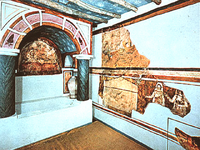Priests and smells and bells do not change the history. I've been to an Orthodox liturgy a few times. A friend of mine just got married. I found it unconvincing everytime I've gone.
The whole time, I'm staring at the images of Christ and thinking about the Second Commandment. I'm hearing the prayers to Mary and I'm thinking about how "there is one Mediator between God and men, Christ Jesus." Not to mention the homily (preaching) is only about 10 minutes long.
Perhaps if you instead tried thinking about and focusing on Christ in a humble way, and praying to Him for discernment, you might have a different experience? Just an idea. If you go in there with a negative attitude and thinking it's all wrong and not being open you probably aren't going to get much out of it.
Regarding the second commandment, this pertains to
idolatry, for example worshiping created images as gods - "of anything that is in heaven above, or that is in the earth beneath, or that is in the water under the earth. You shall not bow down to them or serve them." It doesn't forbid
all images. For example in the Old Testament, God Himself commanded Moses to make images such as the cherubim on the Ark of the Covenant (Exodus 25:18-22) and the bronze serpent in the wilderness (Numbers 21:8-9). However as you are well aware that was the
old covenant. We honor and revere it but it has been superceded by the
new covenant. As Hebrews 10:1 says, “the law has but a shadow of the good things to come instead of the true form of these realities.”
If that was your standard for everything then protestantism doesn't hold up, either. The Incarnation changes everything however: Christ, the eternal Logos took on visible, material flesh (John 1:14). Since God revealed Himself in visible form, to depict Him is not idolatry but a confession of the truth of the Incarnation. As St. John of Damascus wrote: “When the invisible One became visible in the flesh, you may then depict the likeness of Him who was seen.” So that's for starters. Again, don't take my word for it. If you had a quality conversation with an Orthodox Priest they could explain all of these things for you.
Regarding Mary, Orthodox Christians distinguish between
worship (latreia) and
veneration/honor (douleia).
Only God is worshiped. It's actually in my signature if you hadn't noticed before. Mary and the saints are
honored because of their union with Christ. In Revelation 5:8 the prayers of the Saints rise before God like incense and in 1 Timothy 2:1-3 Paul urges believers to intercede for one another.
If the prayers of living Christians help us, how much more the prayers of those perfected in Christ? It is on this basis that Mary and the Saints are venerated,
not worshipped. Mary is special and honored above the rest because she is Theotokos, the “God-bearer” (Luke 1:43: “the mother of my Lord”). She herself prophesied: “All generations will call me blessed” (Luke 1:48), however again she is not Christ and is never worshipped as God or "a god", or anything remotely like that.
An example of something one might do is to pray "Mary and the Saints, I'm having problem XYZ and I could really use some help. Please have mercy and intercede before the Father for me and ask Him to help me with this issue." And they would typically also be praying directly to God for help as well, because this is not a substitute for that. As a former protestant I can certainly understand why that might initially seem weird or even wrong, but it's no different than asking your pastor or a friend at church to pray for you, with the obvious exception that those people aren't in Heaven with direct access to God.
The bottom line is praying to Mary and the Saints - not worshipping them as Gods - is not replacing Christ but only asking our elder brothers and sisters in the faith to intercede for us before Him. Just as we ask friends to pray for us on earth, we ask the glorified in heaven to pray for us. This is basic Orthodoxy 101 stuff and the fact that you don't even understand what we actually believe explains to me why you say the things you do. Please at least take the time to properly understand something before attacking and criticizing it.
In Christ,
SoC




